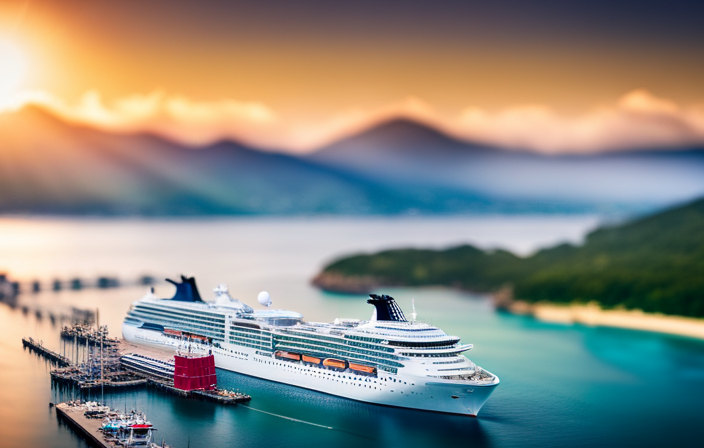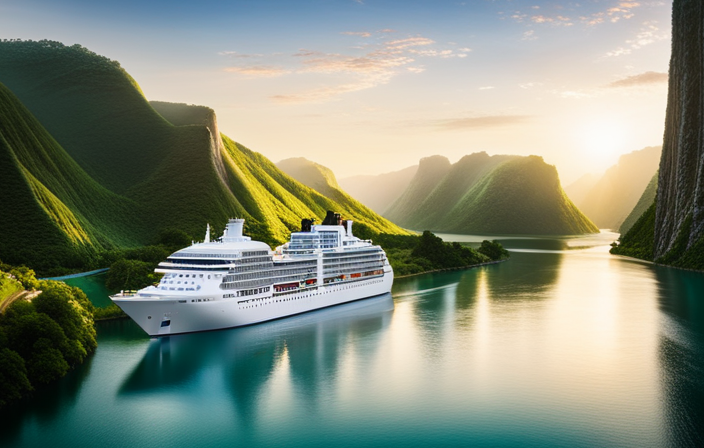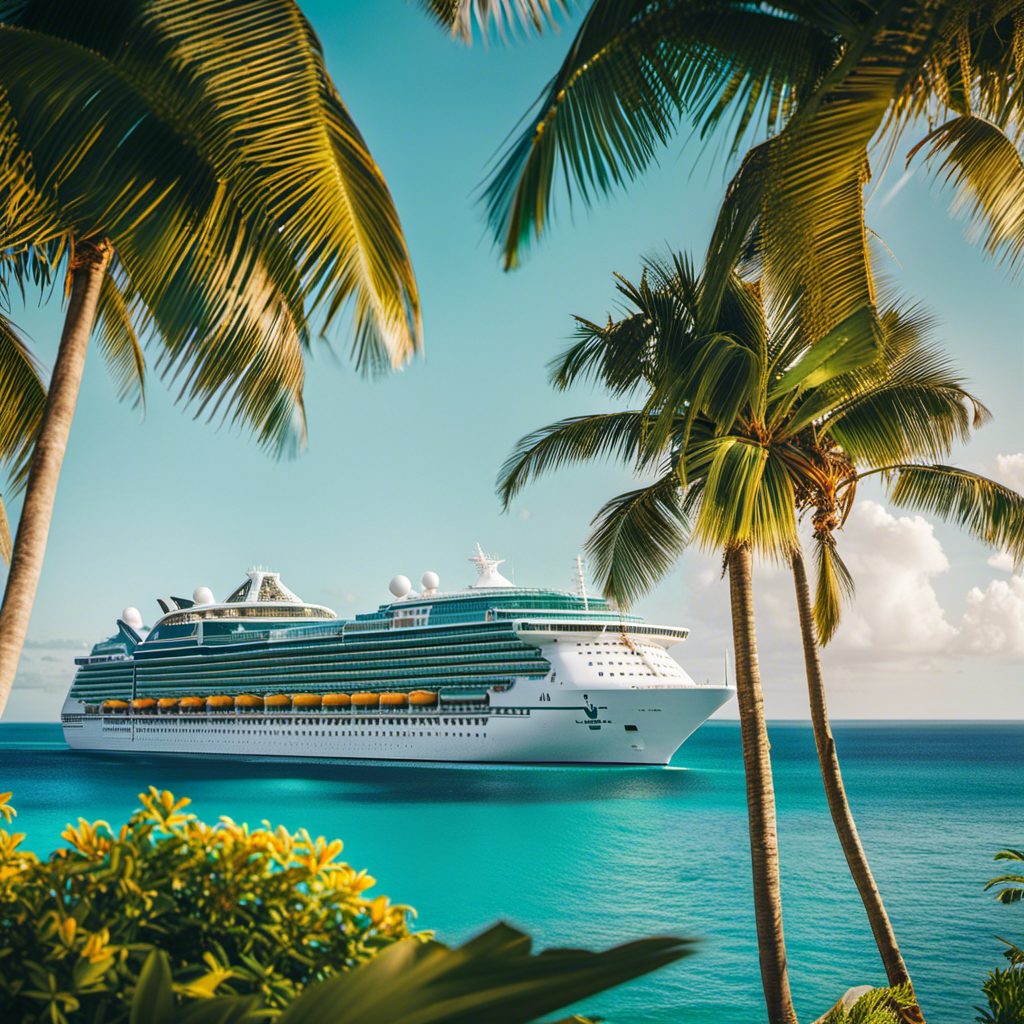As someone who has a deep love for travel and cruising, I have always been intrigued by the intricate workings of a cruise ship. One vital component that passengers often overlook, but is essential for the seamless functioning of a cruise ship, is the gangway.
The gangway, a connecting bridge between the ship and the shore, is a vital component that ensures seamless embarkation and disembarkation for both passengers and crew members. Its design and structure are meticulously crafted to accommodate the varying heights and angles of different ports.
Not only does the gangway facilitate safe transitions between the ship and the shore, but it also adheres to strict safety measures and regulations to guarantee the well-being of everyone on board.
In this article, we will delve into the importance of the gangway in cruise ship operations, explore the latest innovations in gangway technology, and discuss its impact on accessibility for passengers with disabilities.
So, let’s set sail and venture into the fascinating world of the gangway on a cruise ship.
Key Takeaways
- The gangway on a cruise ship is an important component that prioritizes accessibility for passengers with disabilities, providing innovative solutions to address their challenges during embarkation and disembarkation.
- Advancements in gangway technology have revolutionized accessibility, with features such as adjustable ramps, sturdy handrails, non-slip surfaces, and wheelchair lifts, leading to smoother and safer transitions for passengers with disabilities.
- Regular maintenance and thorough inspection of the gangway are necessary to ensure its safety and functionality, including checks for wear and tear, loose or damaged components, and addressing any malfunctions or failures.
- Future trends in cruise ship gangway designs focus on efficiency, safety, and passenger experience, with the use of sustainable materials, advanced technologies like automated boarding systems and adjustable heights, and a continued emphasis on improving the overall passenger experience.
The Importance of the Gangway in Cruise Ship Operations
The gangway is absolutely crucial in cruise ship operations, ensuring smooth embarkation and disembarkation of passengers.
Gangway efficiency is of utmost importance, as it directly impacts the overall flow of passengers during boarding and debarking processes.
The gangway acts as a bridge connecting the ship to the shore, allowing passengers to safely and conveniently move between the two.
It must be designed to accommodate a large volume of people, ensuring a quick and efficient transfer.
Additionally, gangway security is paramount, as it serves as the main access point for passengers entering or leaving the ship.
The gangway is equipped with security measures such as surveillance cameras and restricted access points to ensure the safety of all onboard.
Understanding the design and structure of the gangway is crucial for cruise ship operators to maintain a seamless and secure operation.
Understanding the Design and Structure of the Gangway
Understanding the design and structure of the gangway is essential for ensuring the safety and convenience of passengers and crew during embarkation and disembarkation. The gangway is typically made of steel or aluminum, providing durability and stability. It is designed with non-slip surfaces and handrails to ensure secure footing and support. The gangway also includes a telescoping feature that allows it to adjust to the varying heights of the ship and the port. Lighting systems are installed on gangways to provide visibility during nighttime operations. Overall, the careful design and construction of the gangway facilitate smooth and efficient movement of people between the ship and the port, enhancing the overall experience of a cruise vacation.
How the Gangway Facilitates Passenger and Crew Embarkation and Disembarkation
The gangway is designed to provide a secure and stable pathway for passengers and crew members to embark and disembark from the ship. It acts as a bridge, connecting the ship to the land, and makes the transition between the two seamless. Passengers can easily walk onto the gangway, feeling confident in its stability and safety. Similarly, crew members can efficiently move on and off the ship, ensuring smooth operations.
Regular maintenance is crucial to keep the gangway in optimal condition. This involves inspecting and repairing any structural damages to ensure its functionality. Additionally, accessibility is a key consideration. The gangway must be designed to accommodate passengers with mobility challenges or disabilities, allowing them to easily access the ship. By adhering to strict maintenance protocols and ensuring accessibility, cruise ships can provide a seamless experience for all passengers and crew members.
The Role of the Gangway in Ensuring Smooth Transitions between the Ship and the Shore
As you step off the secure bridge connecting land and sea, the gangway seamlessly facilitates the transition between the vibrant energy on board and the captivating experiences waiting ashore. The gangway plays a crucial role in enhancing the overall passenger experience.
It provides a safe and convenient passage for passengers to embark and disembark from the ship, ensuring a smooth transition between the ship and the shore. However, there are certain challenges associated with gangways, such as varying sea conditions, different port infrastructures, and passenger flow management.
To overcome these challenges, cruise ships employ innovative solutions, such as adjustable gangways to accommodate different heights and angles, and advanced gangway control systems to ensure stability and safety. These solutions ensure that passengers can easily access the ship and enjoy their shore excursions.
Transitioning into the next section, safety measures and regulations associated with the gangway are of utmost importance to ensure the well-being of both passengers and crew.
Safety Measures and Regulations Associated with the Gangway
Once you set foot on the secure bridge connecting land and sea, you will witness stringent safety measures and regulations that ensure a smooth transition between the vibrant energy on board and the captivating experiences waiting ashore.
Safety regulations play a vital role in the design and operation of gangways on cruise ships. These regulations dictate the width, height, and stability of the gangway to ensure passenger safety.
Gangways are equipped with handrails on both sides, non-slip surfaces, and sufficient lighting for enhanced visibility. Additionally, gangways are subject to regular inspections and maintenance to ensure their structural integrity and functionality.
The design of the gangway is carefully engineered to facilitate easy embarkation and disembarkation, with features such as adjustable heights, pivoting connections, and telescopic sections.
These safety measures and regulations ensure that passengers can safely transition between the ship and the shore.
As we delve further into the topic, we will explore the different types of gangways used on cruise ships.
Different Types of Gangways Used on Cruise Ships
When you first approach the secure bridge connecting land and sea, you’ll notice various types of gangways that seamlessly bridge the gap between the magnificent vessel and the captivating shore.
Gangway maintenance is a crucial aspect of ensuring passenger safety and smooth embarkation and disembarkation processes. Regular inspections and repairs are conducted to ensure that gangways are in optimal condition, free from any defects or hazards.
Gangway safety is also prioritized through the implementation of safety measures such as non-slip surfaces, handrails, and proper lighting. These precautions aim to minimize the risk of accidents or injuries while passengers transition between the ship and the shore.
As technology advances, innovative features such as automatic leveling systems and adjustable lengths have been introduced to enhance the functionality and safety of gangways. These advancements will be further explored in the following section on innovations and advancements in gangway technology.
Innovations and Advancements in Gangway Technology
Get ready to discover the exciting advancements that will revolutionize your experience when transitioning between the magnificent vessel and the captivating shore! The gangway technology on cruise ships has seen significant innovations, particularly in terms of materials used and security features incorporated. Gangways are now made from lightweight yet durable materials such as aluminum and carbon fiber, ensuring stability and ease of use. Additionally, gangways now come equipped with advanced security features like biometric scanners, CCTV cameras, and motion sensors to enhance passenger safety. To emphasize the importance of these advancements, consider the following table:
| Gangway Materials | Gangway Security Features | Gangway Advantages |
|---|---|---|
| Aluminum | Biometric scanners | Lightweight |
| Carbon Fiber | CCTV cameras | Durable |
| Motion sensors | Enhanced safety |
These advancements in gangway technology have greatly improved accessibility for passengers with disabilities, ensuring a seamless transition from ship to shore for all individuals.
The Gangway’s Impact on Accessibility for Passengers with Disabilities
Embrace the irony of it all, as the gateway to freedom becomes a beacon of inclusion, effortlessly bridging the gap for passengers with disabilities. Accessibility accommodations for passengers with disabilities have become a priority in the cruise industry. When it comes to embarkation and disembarkation, challenges faced by passengers with disabilities are numerous. The gangway, equipped with innovative technology, addresses these challenges head-on.
- Portable ramps: Gangways now feature portable ramps that can be adjusted to the required height, ensuring easy access for passengers with mobility impairments.
- Handrails and non-slip surfaces: The gangway is equipped with sturdy handrails on both sides, providing stability and support. Non-slip surfaces are also incorporated to prevent accidents.
- Wheelchair lifts: Some gangways are equipped with wheelchair lifts, enabling passengers with mobility devices to effortlessly transition between the ship and the port.
These advancements in gangway technology have revolutionized accessibility for passengers with disabilities, making embarkation and disembarkation smoother and safer. As we delve into the maintenance and inspection of the gangway to ensure its proper functioning, let’s explore the intricate mechanisms that keep this vital component in top condition.
Maintenance and Inspection of the Gangway to Ensure Its Proper Functioning
Ensuring the proper functioning of the gangway requires regular maintenance and thorough inspection.
To maintain the gangway’s functionality, it is important to adhere to specific maintenance requirements. This includes routine cleaning and lubrication of the moving parts, as well as regular checks for any signs of wear and tear.
Additionally, the gangway should be inspected for any loose or damaged components that may compromise its structural integrity. Common issues that may arise include hydraulic system malfunctions, electrical problems, and mechanical failures.
By addressing these issues promptly, the gangway can continue to operate safely and efficiently.
Looking ahead, future trends and developments in cruise ship gangway designs aim to enhance passenger experience and accessibility while maintaining the highest standards of safety and functionality.
Future Trends and Developments in Cruise Ship Gangway Designs
Imagine yourself stepping onto a state-of-the-art gangplank, designed to make your cruise experience more convenient and comfortable.
In the world of cruise ship gangways, futuristic designs are emerging, revolutionizing the way passengers embark and disembark. These modern gangway designs are focused on enhancing efficiency, safety, and passenger experience.
One key aspect of these future gangway designs is the use of sustainable materials. As environmental concerns continue to grow, cruise ship companies are looking for ways to reduce their carbon footprint. Gangway manufacturers are exploring the use of eco-friendly materials such as recycled plastics or renewable resources like bamboo. These materials not only contribute to a greener environment but also ensure the durability and longevity of the gangway.
Moreover, these futuristic gangways are equipped with advanced technologies like automated boarding systems and adjustable heights. These features allow for seamless boarding and disembarking processes, accommodating passengers of different abilities and ensuring their comfort and safety.
Overall, the future of cruise ship gangway designs looks promising, with a focus on sustainability and passenger convenience. As technology continues to advance, we can expect even more innovative and efficient gangway designs in the years to come.
Frequently Asked Questions
How long does it typically take for passengers to embark or disembark using the gangway?
The embarkation process on a cruise ship varies depending on factors such as the ship’s size and number of passengers. On average, it can take anywhere from 30 minutes to a few hours. Disembarkation time also varies, typically ranging from 2 to 4 hours.
Are there any weight restrictions for passengers or luggage when using the gangway?
Passengers must adhere to weight restrictions when using the gangway on a cruise ship. There are also luggage restrictions that must be followed to ensure the safety and efficiency of embarkation and disembarkation processes.
Can the gangway be adjusted to accommodate different water levels?
The gangway on a cruise ship can be adjusted to accommodate different water levels, ensuring stability. With precise adjustments, it adapts to the changing conditions, providing a secure passage for passengers and crew.
Are there any specific safety precautions passengers should take when using the gangway?
When using the gangway, passengers must follow specific safety precautions. These include watching their step, using the handrails, and avoiding any sudden movements. Additionally, regular maintenance and inspections of the gangway ensure its safe usage.
How often does the gangway need to be inspected for maintenance purposes?
The gangway on a cruise ship should be inspected for maintenance purposes at least once every six months. This regular inspection frequency ensures that any issues or damages can be identified and addressed promptly to ensure passenger safety.
Conclusion
In conclusion, the gangway on a cruise ship plays a vital role in ensuring smooth operations and passenger safety. Its design and structure are carefully engineered to facilitate embarkation and disembarkation processes.
By adhering to safety measures and regulations, the gangway guarantees a seamless transition between the ship and the shore. Innovations in gangway technology have improved accessibility for passengers with disabilities, while maintenance and inspection ensure its proper functioning.
As we look to the future, we can expect further advancements in gangway designs to enhance the cruise ship experience.










